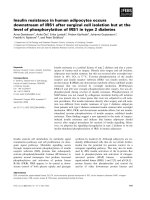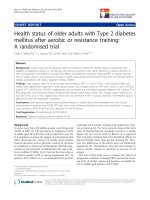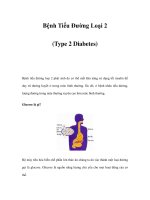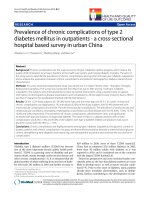- Trang chủ >>
- THPT Quốc Gia >>
- Ngoại Ngữ
ROLES OF THIAZOLIDINEDIONES IN TYPE 2 DIABETES MELLITUS TREATMENT AND WEIGHT GAIN
Bạn đang xem bản rút gọn của tài liệu. Xem và tải ngay bản đầy đủ của tài liệu tại đây (319.65 KB, 8 trang )
<span class='text_page_counter'>(1)</span><div class='page_container' data-page=1>
<b>ROLES OF THIAZOLIDINEDIONES IN TYPE 2 DIABETES </b>
<b>MELLITUS TREATMENT AND WEIGHT GAIN </b>
<b>Tran Quynh Hoa</b>
<b>1,*</b><b><sub>, Nguyen Dinh Quan</sub></b>
<b>2</b><b><sub>, Nguyen Minh Nam</sub></b>
<b>3 </b><i>1</i>
<i>Ho Chi Minh City University of Food Industry </i>
<i>2</i>
<i>R&D Department, Sanofi Pharmaceuticals Company, Vietnam </i>
<i>3</i>
<i>School of Medicine, VNU-HCM </i>
<i>*Email: </i>
Received: 26 June 2020; Accepted: 21 August 2020
<b>ABSTRACT </b>
Type 2 diabetes mellitus is a serious public health problem in the world and its
treatment is still a major therapy challenge. Thiazolidinediones (TZDs) are a class of
anti-diabetic drugs that are used widely to increase insulin sensitivity by activating
Peroxisome-Proliferator-Activated-Receptor-gamma (PPARγ). Activated PPARγ makes critical alterations
in the transcription of genes that regulate glucose and lipid metabolism. However, TZDs
have side effects, such as weight gain, edema, congestive heart failure, and bone fracture.
Also, they stimulate adipogenesis and hyperphagia, and cause weight gain. In this review, we
discuss the mechanism by which TZDs increase insulin sensitivity, and cause weight gain.
<i><b>Keywords: Thiazolidinediones, weight gain, diabetes, insulin, PPARγ. </b></i>
<b>1. INTRODUCTION </b>
</div>
<span class='text_page_counter'>(2)</span><div class='page_container' data-page=2>
<b>2. MECHANISM, METABOLISM, AND INTERACTION OF THIAZOLIDINEDIONES </b>
<b>2.1. The mechanism of TZDs on type 2 diabetes mellitus </b>
Peroxisome Proliferator-Activated Receptor gamma (PPARγ) is a key regulator of
adipogenesis. PPARγ belongs to the nuclear receptor superfamily of ligand-inducible
transcription factor [9, 10]. It expresses highly in white and brown adipocytes and controls
the genes that involve in adipocyte differentiation, lipid metabolism, and insulin sensitivity.
PPARγ has been well characterized, and used as a molecular target of many agonists for the
treatment of diabetes [11].
TZDs, including troglitazone, pioglitazone, and rosiglitazone, are a group of PPARγ
agonists which have been approved for clinical use in the treatment of type 2 diabetes since
1997. They exert their anti-diabetic effects by increasing insulin sensitivity via activation of
PPARγ [6, 7]. There are several ways by which TZDs inhibit the levels of hyperglycaemia
and hyperinsulinaemia and enhance insulin sensitivity in the liver, muscle, and adipocytes
tissue. In one way, TZDs promote binding of the PPARγ-RXR complex to
Peroxisome-Proliferator-Response-Elements (PPRE) in the promoter region of key target genes that are
involved in glucose and lipid metabolism, and in energy balance [7, 12]. In another way,
TZDs ameliorate insulin resistance by activating endocrine signaling from adipocytes to
skeletal muscle cells via activation of PPARγ. Furthermore, TZDs mediate glucose
homeostasis by the reduction of FFA levels [13-15]. It has been suggested that TZDs also
protect pancreatic beta cell function [15, 16]. In addition, TZDs suppress or neutralize the
action of adipocyte-derived tumor necrosis factor-α (TNF-α), which is expressed highly in
obesity and insulin resistance, and is able to induce a variety of catabolic effects [17-19].
Moreover, TZDs have been found to enhance insulin signaling by stimulating tyrosine
phosphorylation of insulin receptor, and insulin receptor substrate 1 (IRS-1), and inhibiting
the MAPK pathway [19, 20]. Recently, it has been reported that TZDs increase adiponectin
secretion in adipose tissue, inhibit lipolysis, and release of transforming growth
factor-β (TGF-β) [6, 21]. Furthermore, TZDs block the Ser273 phosphorylation of PPARγ by
cyclin-dependent kinase (Cdk) 5, and prevent the development of insulin resistance [22].
Taken together, the data suggest that TZDs have beneficial effects on insulin sensitivity, and
insulin resistance via the activation of the PPARγ.
<b>2.2. Metabolic pathway and drug interactions of TZDs </b>
</div>
<span class='text_page_counter'>(3)</span><div class='page_container' data-page=3>
<b>2.3. TZDs exert weight gain </b>
In clinical trials, treatment with TZDs were associated with weight gain [25, 26]. Compared
with the placebo group, the body weight of patients treated with pioglitazone was significantly
increased after 12 weeks (1.68 ± 2.46 kg, p = 0.04) and after 24 weeks (3.88 ± 3.11 kg). In
contrast, body weight in the placebo group decreased by 0.79 ± 3.336 kg, although the
decrease was insignificant. Body weight continued to rise throughout the trial in the
pioglitazone-treated group, and had not reached a plateau by the end of the study [27].
The recent studies on Wistar rats have demonstrated the effectiveness of pioglitazone and
rosiglitazone in preventing weight loss and increasing survival in cancer cachexia [28, 29]. The
rats were randomly assigned to two experimental groups: TC (tumor + saline-control) and
TP5 (tumor + pioglitazone 5 mg). Body weight, food ingestion, and tumor growth were
measured at baseline, and after removal of a tumor at days 7, 14, and 26. It was also
enhanced by 40.7% and 56.3% body mass preservation on day 14 and 26, respectively,
compared with the TC group. The pioglitazone treatment also reduced the final tumor mass
<i>(53.4%, p < 0.05) and anorexia, compared with the TC group during late-stage cachexia [28]. </i>
Rosiglitazone reduced average daily weight loss (2.33 g/day rosiglitazone versus 3.93 g/day
<i>placebo; p < 0.05) as a result of both fat and lean mass preservation. It decelerated white and </i>
brown tissue wasting. But had no effect on skeletal muscle mass and heart mass [29]. TZDs
increase body weight largely due to increased fat pad mass, and alterations in adipocyte
size and numbers. The zucker diabetic fatty rats were administered pioglitazone orally
(20 mg/kg/day) for 4 weeks. Then, consumption and body weight were significantly greater
than that of the control group [30].
Several studies compared the side effect on weight gain of TZDs, and sulfonylurea
when combined with metformin [31-34]. In a randomized, double-blind study, Matthews
compared the efficacy and safety of metformin and pioglitazone, with the established
combination of metformin and gliclazide. Patients received either metformin at pre-study
dose plus pioglitazone (15-45 mg daily), or metformin at pre-study dose plus gliclazide
(80-320 mg daily). The body weight increased 1.5 kg in the metformin plus pioglitazone group,
and 1.4 kg in the metformin plus gliclazide group. Both are not statistically significant
compared to the baseline. By week 52, body weight in both groups appeared to have stabilized.
The mean weight gain over 52 weeks was similar in both groups and plateaued by the end of
<i>the study [31]. Also, Charbonnel et al. and Seufert et al. compared adding pioglitazone </i>
(15-45 mg daily) with adding gliclazide (80-320 mg daily) to metformin (850-2550 mg daily)
<i>[32, 33]. Charbonnel et al. found weight increases of 2.5 kg in the pioglitazone, and 1.2 kg in </i>
the gliclazide add-on groups, but both are not statistically significant [32]. The study of
<i>Seufert et al. conducted for 2 years also had similar results. An increase of 2.3 kg in the </i>
<i>mean weight when pioglitazone was added to metformin (N = 317) and 1.1 kg when </i>
<i>gliclazide was added to metformin (N = 313) [33]. Also, Ceriello et al. compared the effect </i>
of pioglitazone and gliclazide on the weight gain. Then, there was no significant difference
between the pioglitazone group and the gliclazide group. Similarly, no significant
difference in weight gain between pioglitazone and gliciazide was observed when these
two were used singularly or in cotherapy with metformin [34]. TZDs may cause more
weight gain than sulfonylurea. But the weight gains caused by pioglitazone or gliclazide are
not significantly different. The weight gain level is not similar in every case with TZDs
treatment.
</div>
<span class='text_page_counter'>(4)</span><div class='page_container' data-page=4>
plus sulfonylurea versus metformin plus sulfonylurea study, the mean weight change in the
pioglitazone plus sulfonylurea group (2.6 kg) from baseline was different from that of the
<i>metformin plus sulfonylurea group (-1.5 kg) [34]. In a study conducted by Seufert et al., the </i>
results showed similar trend that the weight increased by 3.2 kg in the combination of
<i>pioglitazone with sulfonylurea (N = 319) and decreased by 1.7 kg in the metformin added to </i>
<i>sulfonylurea group (N = 320) [33]. The above data suggest that metformin causes weight loss </i>
in many patients while pioglitazone exerts weight gain in most of the cases. Thus, the
combination of pioglitazone with metformin may help to improve glycemic control and
reduce the risks of changes in body weight.
<b>2.4. The mechanism of TZDs on weight gain </b>
Despite their potential to cause weight gain, TZDs improve glycemic control, and
insulin sensitivity in type 2 diabetes mellitus patients [35]. Many studies attempt to clarify
the mechanisms behind the paradoxical effect of TZDs: Improving insulin sensitivity while
causing weight gain. TZDs improve insulin sensitivity and cause weight gain by increasing
circulating adiponectin levels. Two distinct receptors, AdipoR1 and AdipoR2, are regulated
by adiponectin concentrate. Pioglitazone increases insulin sensitivity via upregulation of
AdipoR2-mediated AMPK-activated protein kinase phosphorylation in 3T3-L1 adipocytes.
TZDs were found to directly bind and activate PPAR-γ. One activated PPAR-γ,
adiponectin was induced in expression leading to inducing the expression of AdipoR2 [36].
AMPK, a key molecule in the adipoR-mediated signaling pathway, was activated under
pioglitazone treatment. In 3T3-L1 adipocytes, pioglitazone increases insulin sensitivity by
promoting GLUT4 expression via AdipoR2-mediated AMPK-activated protein kinase
phosphorylation [13, 36].
TZDs therapy has beneficial effects on glycemic control and insulin sensitivity. But it
causes a weight gain side effect. Several studies showed that possible causes of weight gain
with TZDs treatment are increased adipogenesis and fluid retention [35, 37]. Pioglitazone
treatment leads to increasing circulating adiponectin, that reaches the hypothalamus in the
central nervous system. Possibly, the increased adiponectin in the hypothalamus results in
increased phosphorylation of hypothalamic AMPK via adipoR1 [38], this may lead to
increased food intake, and eventually contributes to the increase in body weight with
pioglitazone treatment. Conversely, inhibition of AMPK phosphorylation or AdipoR1
expression in the hypothalamus may cause the reversal of the obese phenotype shown by the
rat group treated only with pioglitazone [38, 39].
</div>
<span class='text_page_counter'>(5)</span><div class='page_container' data-page=5>
<i>Figure 1. Schematic of the hypothetical mechanism in weight gain and insulin sensitivity in TZDs </i>
treatment. TZDs promote insulin sensitivity by AdipoR2-mediated AMPK phosphorylation in
adipocytes. Circulating adiponectin stimulated by TZDs led to increasing phosphorylation of AMPK
in the hypothalamus. This increased AdipoR1 expression and caused the reversal of weight gain.
<b>3. CONCLUSIONS </b>
We have overviewed TZDs and their side effects with a focus on the mechanisms of
weight gain. The chain PPARγ/Adiponectin/AdipoR1/AMPK partially responsible for the
weight gain in TZDs treatment was summarized in Figure 1. Another chain,
PPARγ/Adiponectin/AdipoR2/AMPK, is the response to TZDs treatment to improve insulin
sensitivity in adipocytes. Combining treatment of TZDs with metformin may reduce the risks of
changes in body weight and control glycemic in diabetes mellitus patients. TZDs may cause
weight gain in treatment now, but the development of next generation of TZDs or
PPARγ agonists is expected to have fewer side effects.
<i><b>Acknowledgments: The authors are grateful to H. Vic Dannon, Ph.D. for his assistance in </b></i>
rectification of this manuscript.
<b>REFERENCES </b>
1. American Diabetes Association. - 2. Classification and diagnosis of diabetes,
<b>Diabetes Care 38 (Supplement 1) (2015) S8-S16. </b>
<b>2. Scully T. - Diabetes in numbers, Nature 485 (7398) (2012) S2-3. </b>
3. Shaw J.E., Sicree R.A., Zimmet P.Z. - Global estimates of the prevalence of diabetes
<b>for 2010 and 2030, Diabetes Res Clin Pract 87 (1) (2010) 4-14. </b>
4. Inzucchi S.E., Bergenstal R.M., Buse J.B., Diamant M., Ferrannini E., Nauck M.,
Peters A.L., Tsapas A., Wender R., Matthews D.R. - Management of hyperglycemia
in type 2 diabetes, 2015: a patient-centered approach: update to a position statement
of the American Diabetes Association and the European Association for the Study of
<b>Diabetes, Diabetes Care 38 (1) (2015) 140-149. </b>
5. Goldstein B.J. - Insulin resistance as the core defect in type 2 diabetes mellitus,
<b>American Journal of Cardiology 90 (5A) (2002) 3G-10G. </b>
</div>
<span class='text_page_counter'>(6)</span><div class='page_container' data-page=6>
<b>7. Jarvinen H.Y. - Thiazolidinediones, New England Journal of Medicine 351 (11) </b>
(2004) 1106-1118.
8. Wang S., Dougherty E.J., Danner R.L. - PPARγ signaling and emerging opportunities
<b>for improved therapeutics, Pharmacological Research 111 (2016) 76-85. </b>
9. Evans R.M., Barish G.D., Wang Y.X. - PPARs and the complex journey to obesity,
<b>Nat Med 10 (4) (2004) 355-361. </b>
10. Tontonoz P., Spiegelman B.M. - Fat and beyond: the diverse biology of PPARgamma,
<b>Annu Rev Biochem 77 (2008) 289-312. </b>
11. Larsen T.M., Toubro S., Astrup A. - PPARgamma agonists in the treatment of type
II diabetes: is increased fatness commensurate with long-term efficacy?, Int J Obes
<b>Relat Metab Disord 27 (2) (2003) 147-161. </b>
12. Staels B., Fruchart J.C. - Therapeutic roles of peroxisome proliferator-activated
<b>receptor agonists, Diabetes 54 (8) (2005) 2460-2470. </b>
13. Reginato M.J., Lazar M.A. - Mechanisms by which thiazolidinediones enhance
<b>insulin action, Trends Endocrinol Metab 10 (1) (1999) 9-13. </b>
14. Jermendy G., Csermely P. - Thiazolidinediones--a new class of oral antidiabetic
<b>drugs, Orv Hetil 142 (29) (2001) 1547-1554. </b>
<b>15. Day C. - Thiazolidinediones: a new class of antidiabetic drugs, Diabet Med 16 (3) </b>
(1999) 179-192.
16. Buchanan T.A., Xiang A.H., Peters R.K., Kjos S.L., Marroquin A., Goico J.,
Ochoa C., Tan S., Berkowitz K., Hodis H.N., Azen S.P. - Preservation of pancreatic
beta-cell function and prevention of type 2 diabetes by pharmacological treatment of
<b>insulin resistance in high-risk hispanic women, Diabetes 51 (9) (2002) 2796-2803. </b>
17. Hotamisligil G.S., Spiegelman B.M. - Tumor necrosis factor alpha: a key component
<b>of the obesity-diabetes link, Diabetes 43 (11) (1994) 1271-1278. </b>
18. Katsuki A., Sumida Y., Murata K., Furuta M., Araki-Sasaki R., Tsuchihashi K., Hori
Y., Yano Y., Gabazza E.C., Adachi Y. - Troglitazone reduces plasma levels of
tumour necrosis factor-alpha in obese patients with type 2 diabetes, Diabetes,
<b>Obesity and Metabolism 2 (3) (2000) 189-191. </b>
19. Peraldi P., Xu M., Spiegelman B.M. - Thiazolidinediones block tumor necrosis
factor-alpha-induced inhibition of insulin signaling, Journal of Clinical Investigation
<b>100 (7) (1997) 1863-1869. </b>
20. Defronzo R.A. - Banting Lecture. From the triumvirate to the ominous octet: a new
<b>paradigm for the treatment of type 2 diabetes mellitus, Diabetes 58 (4) (2009) 773-795. </b>
21. Eldor R., DeFronzo R.A., Ghani M.A. - In vivo actions of peroxisome
proliferator-activated receptors: glycemic control, insulin sensitivity, and insulin secretion,
<b>Diabetes Care 36 (Suppl 2) (2013) S162-S174. </b>
22. Choi J.H., Banks A.S., Estall J.L., Kajimura S., Bostrom P., Laznik D., Ruas J.L.,
Chalmers, T.M. Kamenecka M.J., Bluher M., Griffin P.R., Spiegelman B.M. -
Anti-diabetic drugs inhibit obesity-linked phosphorylation of PPARgamma by Cdk5,
<b>Nature 466 (7305) (2010) 451-456. </b>
23. Jaakkola T., Laitila J., Neuvonen P.J., Backman J.T. - Pioglitazone is metabolised by
CYP2C8 and CYP3A4 in vitro: potential for interactions with CYP2C8 inhibitors,
<b>Basic & Clinical Pharmacology and Toxicology 99 (1) (2006) 44-51. </b>
</div>
<span class='text_page_counter'>(7)</span><div class='page_container' data-page=7>
25. Fonseca V., Foyt H.L., Shen K., Whitcomb R. - Long-term effects of troglitazone:
<b>open-label extension studies in type 2 diabetic patients, Diabetes Care 23 (3) (2000) </b>
354-359.
26. Mori Y., Murakawa Y., Okada K., Horikoshi H., Yokoyama J., Tajima N., Ikeda Y.
- Effect of troglitazone on body fat distribution in type 2 diabetic patients, Diabetes
<b>Care 22 (6) (1999) 908-912. </b>
27. Smith S.R., De Jonge L., Volaufova J., Li Y., Xie H., Bray G.A. - Effect of
pioglitazone on body composition and energy expenditure: a randomized controlled
<b>trial, Metabolism 54 (1) (2005) 24-32. </b>
28. Beluzi M., Peres S.B., Henriques F.S., Sertie R.A., Franco F.O., Santos K.B., Knobl
P., Andreotti S., Shida C.S., Neves R.X., Farmer S.R., Seelaender M., Lima F.B.,
Batista M.L.Jr. - Pioglitazone treatment increases survival and prevents body weight
<b>loss in tumor-bearing animals: possible anti-cachectic effect, PLoS One 10 (3) </b>
(2015) e0122660.
29. Trobec K., Palus S., Tschirner A., Haehling S.V, Doehner W., Lainscak M., Anker
S.D., Springer J. - Rosiglitazone reduces body wasting and improves survival in a rat
<b>model of cancer cachexia, Nutrition 30 (9) (2014) 1069-1075. </b>
30. Saitoh Y., Liu R., Ueno H., Mizuta M., Nakazato M. - Oral pioglitazone
administration increases food intake through ghrelin-independent pathway in Zucker
<b>fatty rat, Diabetes Res Clin Pract 77 (3) (2007) 351-356. </b>
31. Matthews D.R., Charbonnel B.H., Hanefeld M., Brunetti P., Schernthaner G. -
Long-term therapy with addition of pioglitazone to metformin compared with the
addition of gliclazide to metformin in patients with type 2 diabetes: a randomized,
<b>comparative study, Diabetes Metab Res Rev 21 (2) (2005) 167-174. </b>
32. Charbonnel B., Schernthaner G., Brunetti P., Matthews D.R., Urquhart R., Tan
M.H., Hanefeld M. - Long-term efficacy and tolerability of add-on pioglitazone
therapy to failing monotherapy compared with addition of gliclazide or metformin in
<b>patients with type 2 diabetes, Diabetologia 48 (6) (2005) 1093-1104. </b>
33. Seufert J., Urquhart R. - 2-year effects of pioglitazone add-on to sulfonylurea or
metformin on oral glucose tolerance in patients with type 2 diabetes, Diabetes Res
<b>Clin Pract 79 (3) (2008) 453-460. </b>
34. Ceriello A., Johns D., Widel M., Eckland D.J., Gilmore K.J., Tan M.H. -
Comparison of effect of pioglitazone with metformin or sulfonylurea (monotherapy
and combination therapy) on postload glycemia and composite insulin sensitivity
index during an oral glucose tolerance test in patients with type 2 diabetes, Diabetes
<b>Care 28 (2) (2005) 266-272. </b>
35. Fonseca V. - Effect of thiazolidinediones on body weight in patients with diabetes
<b>mellitus, Am J Med 115 (Suppl 8A) (2003) 42S-48S. </b>
36. Kudoh A., Satoh H., Hirai H., Watanabe T. - Pioglitazone upregulates adiponectin
<b>receptor 2 in 3T3-L1 adipocytes, Life Sci 88 (23-24) (2011) 1055-1062. </b>
<b>37. Lehrke M., Lazar M.A. - The many faces of PPARgamma, Cell 123 (6) (2005) </b>
993-999.
</div>
<span class='text_page_counter'>(8)</span><div class='page_container' data-page=8>
39. Minokoshi Y., Alquier T., Furukawa N., Kim Y.B., Lee A., Xue B., Mu J., Foufelle
F., Ferre P., Birnbaum M.J., Stuck B.J., Kahn B.B. - AMP-kinase regulates food
intake by responding to hormonal and nutrient signals in the hypothalamus, Nature
<b>428 (6982) (2004) 569-574. </b>
40. Beltowski J., Rachanczyk J., Wlodarczyk M. - Thiazolidinedione-induced fluid
<b>retention: recent insights into the molecular mechanisms, PPAR Research 2013 </b>
(2013) 628628.
41. Guan Y., Hao C., Cha D.R., Rao R., Lu W., Kohan D.E., Magnuson M.A., Redha
R., Zhang Y., Breyer M.D. - Thiazolidinediones expand body fluid volume through
<b>PPARgamma stimulation of ENaC-mediated renal salt absorption, Nat Med 11 (8) </b>
(2005) 861-866.
42. Viswanathan V., Mohan V., Subramani P., Parthasarathy N., Subramaniyam G.,
Manoharan D., Sundaramoorthy C., Gnudi L., Karalliedde J., Viberti G. - Effect of
spironolactone and amiloride on thiazolidinedione-induced fluid retention in South
Indian patients with type 2 diabetes, Clinical Journal of the American Society of
<b>Nephrology 8 (2) (2013) 225-232. </b>
<b>TĨM TẮT </b>
VAI TRỊ CỦA THIAZOLIDINEDIONE
TRONG ĐIỀU TRỊ ĐÁI THÁO ĐƯỜNG TUÝP 2 VÀ HIỆN TƯỢNG TĂNG CÂN
Trần Quỳnh Hoa1,*<sub>, Nguyễn Đình Quân</sub>2<sub>, Nguyễn Minh Nam</sub>3
<i>1</i>
<i>Trường Đại học Công nghiệp Thực phẩm TP.HCM </i>
<i>2<sub>Phịng Nghiên cứu và Phát triển, Cơng ty Dược phẩm Sanofi, Vietnam </sub></i>
<i>3<sub>Khoa Y, Đại học Quốc gia TP.HCM </sub></i>
<b>*</b><i><sub>E-mail: </sub></i>
Đái tháo đường tuýp 2 là một bệnh lý nghiêm trọng đối với sức khỏe cộng đồng. Điều
trị đái tháo đường tuýp 2 vẫn là một thách thức lớn. Thiazolidinediones (TZDs) là một trong
những nhóm thuốc điều trị đái tháo đường được sử dụng rộng rãi để cải thiện tình trạng
kháng insulin bằng cách kích hoạt thụ thể PPARγ, dẫn đến những thay đổi quan trọng trong
quá trình phiên mã của một số gen điều hịa chuyển hóa glucose và chất béo. Tuy nhiên, bên
cạnh vai trị hữu ích trong điều trị đái tháo đường tuýp 2, các TZD cũng gây ra những tác
dụng không mong muốn như: tăng cân, phù, suy tim sung huyết và gãy xương. Các thuốc
TZD gây tăng trọng lượng cơ thể vì chúng kích thích q trình tạo các tế bào mơ mỡ và tăng
nhu cầu thức ăn. Trong bài báo này, chúng tơi sẽ giải thích về cơ chế làm tăng độ nhạy cảm
insulin và tác dụng phụ gây tăng cân của các thuốc TZD trong điều trị đái tháo đường tuýp 2.
</div>
<!--links-->









